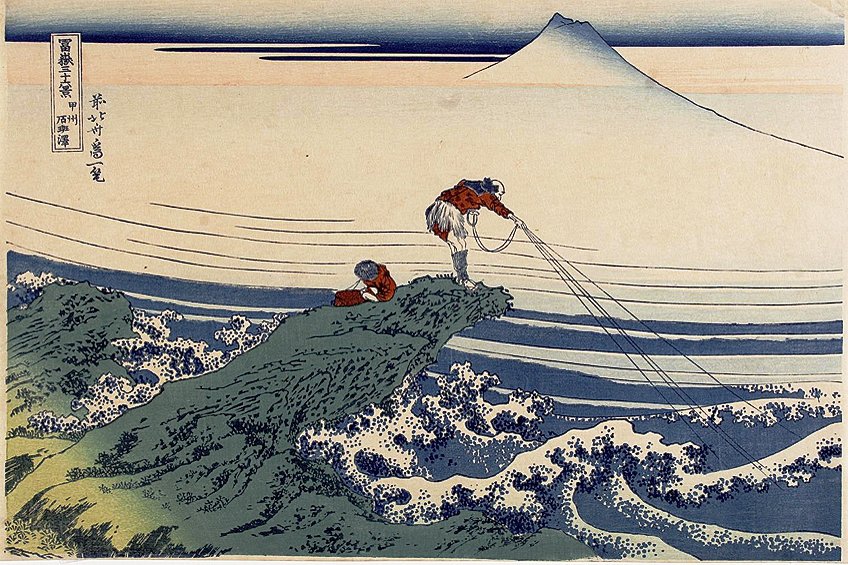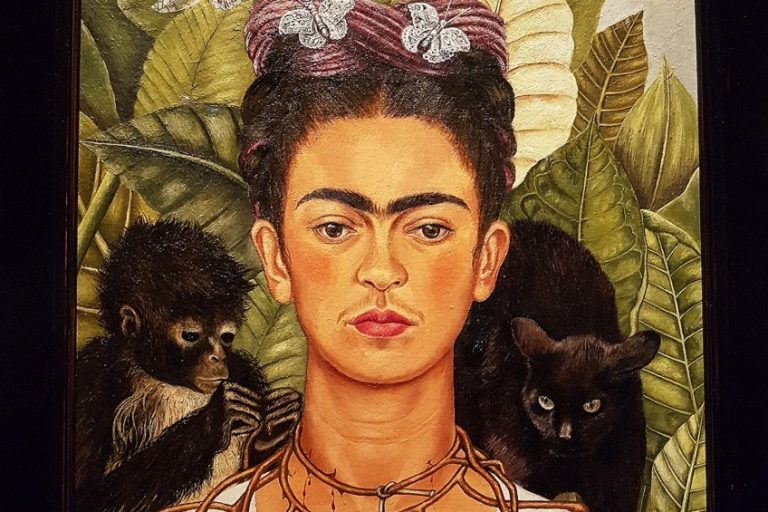Katsushika Hokusai Paintings – A Journey Through Time
Katsushika Hokusai, a master of ukiyo-e woodblock prints during Japan’s Edo period, left an indelible mark on the art world with his iconic and influential works. Renowned for his meticulous craftsmanship, vivid compositions, and unparalleled sense of detail, Hokusai’s art captured the essence of Japanese culture and landscapes with timeless beauty. From the majestic Mount Fuji series to the mesmerizing Great Wave off Kanagawa, Hokusai’s paintings continue to captivate and inspire art enthusiasts worldwide, showcasing his enduring legacy as one of Japan’s most celebrated artists.
Table of Contents
- 1 The Impact of Katsushika Hokusai’s Art
- 2 Top 10 Katsushika Hokusai Paintings to Know
- 2.1 Dream of the Fisherman’s Wife (1814)
- 2.2 Fujimigahara in Owari Province (1830 – 1831)
- 2.3 Kajikazawa in Kai Province (1830 – 1833)
- 2.4 The Great Wave off Kanagawa (1831)
- 2.5 Thunderstorm Beneath the Summit (1831)
- 2.6 Fine Wind, Clear Morning (Red Fuji) (1831)
- 2.7 Thirty-Six Views of Mount Fuji (1831 – 1833)
- 2.8 A Tour of the Waterfalls of the Provinces (1833)
- 2.9 One Hundred Views of Mount Fuji (1834)
- 2.10 Bullfinch and Weeping Cherry Blossoms (1834)
- 3 Frequently Asked Questions
The Impact of Katsushika Hokusai’s Art
Katsushika Hokusai’s art had a profound impact on both Japanese and Western art scenes, shaping the development of various artistic movements and inspiring countless artists across generations. His innovative use of perspective, bold compositions, and meticulous attention to detail revolutionized the traditional ukiyo-e genre, elevating it to a level of artistic sophistication that transcended its origins as popular prints for the masses. Hokusai’s exploration of themes such as nature, mythology, and daily life in Edo-era Japan not only captured the imagination of his contemporaries but also laid the foundation for future artistic expressions.

Furthermore, Hokusai’s influence extended far beyond his lifetime, as his artworks gained recognition and admiration in Europe during the 19th century, particularly among the Impressionists and Post-Impressionists. Artists such as Vincent van Gogh and Claude Monet were captivated by Hokusai’s use of color, form, and composition, incorporating elements of his style into their own works. This cross-cultural exchange not only enriched Western art but also contributed to a global appreciation for Japanese art and aesthetics, highlighting Hokusai’s enduring legacy as a visionary artist whose impact continues to resonate in the art world today.
Top 10 Katsushika Hokusai Paintings to Know
In this section, we delve into the world of Katsushika Hokusai’s top 10 artworks, each a masterpiece in its own right. From iconic landscapes to captivating scenes of nature and mythology, Hokusai’s paintings showcase his unparalleled skill, creativity, and deep connection to Japanese culture. Through dynamic compositions, vibrant colors, and profound themes, these artworks have stood the test of time, leaving a lasting impact on the art world and captivating viewers with their timeless beauty and significance.
Join us as we explore the diverse and remarkable range of Hokusai’s most celebrated paintings.
Dream of the Fisherman’s Wife (1814)
| Date | 1814 |
| Medium | Woodblock print |
| Dimensions (cm) | 19 × 27 |
| Where Is It Housed? | Various collections |
“Dream of the Fisherman’s Wife” is a provocative and enigmatic work depicting a mythical encounter between a woman and two octopuses. The painting’s subject matter, blending eroticism with oceanic elements, sparked discussions about human-animal relationships and the depths of desire. Its importance lies in its innovative portrayal of a dream-like scenario, challenging conventional notions of beauty and the natural world.
The painting’s meaning delves into themes of fantasy, subconscious desires, and the mysterious allure of the sea, inviting viewers to contemplate the boundaries between reality and imagination.
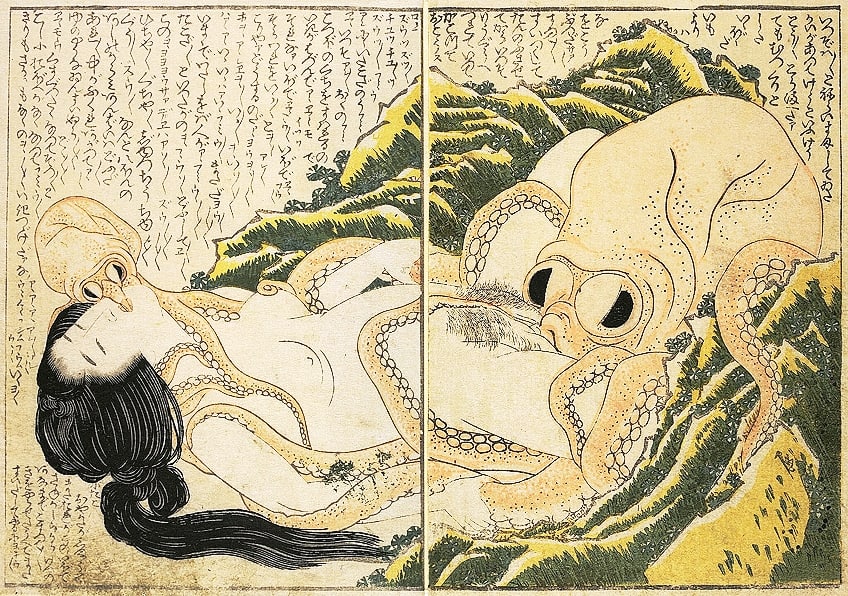
Fujimigahara in Owari Province (1830 – 1831)
| Date | 1830 – 1831 |
| Medium | Woodblock print |
| Dimensions (cm) | 25.7 × 27.3 |
| Where Is It Housed? | Philadelphia Museum of Art, Pennsylvania, United States |
“Fujimigahara in Owari Province” captures a serene and panoramic view of Fujimigahara, a region in Owari Province, under a vast sky. Its importance lies in its depiction of the Japanese countryside, showcasing Hokusai’s mastery of landscapes and atmospheric effects. The painting’s subject matter celebrates the beauty of nature, inviting viewers to appreciate the harmonious relationship between the land and the sky. Its meaning reflects a sense of tranquility, awe-inspiring landscapes, and the artist’s deep connection to the natural world, conveying a timeless sense of beauty and serenity.

Kajikazawa in Kai Province (1830 – 1833)
| Date | 1830 – 1833 |
| Medium | Woodblock print |
| Dimensions (cm) | 25.7 × 38 |
| Where Is It Housed? | Metropolitan Museum of Art, New York City, United States |
“Kajikazawa in Kai Province” portrays a dramatic scene of crashing waves against a steep cliff in Kai Province, exemplifying Hokusai’s dynamic compositions and mastery of depicting movement. Its importance lies in its ability to capture the power and grandeur of nature, highlighting the artist’s fascination with landscapes and their ever-changing elements. The painting’s subject matter evokes a sense of awe and respect for the forces of nature, encouraging viewers to contemplate the sublime beauty and unpredictability of the natural world.
Its meaning resonates with themes of resilience, strength, and the eternal cycle of creation and destruction.
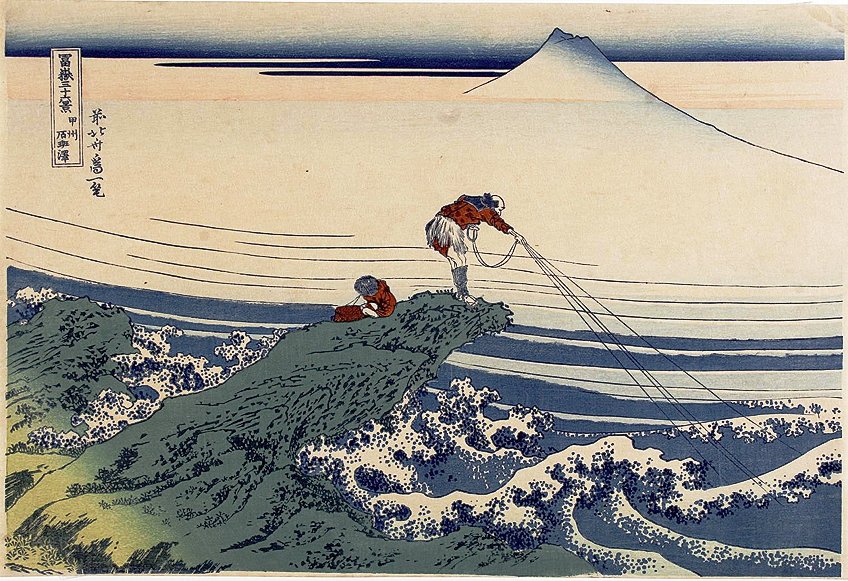
The Great Wave off Kanagawa (1831)
| Date | 1831 |
| Medium | Woodblock print |
| Dimensions (cm) | 25.7 × 37.9 |
| Where Is It Housed? | Metropolitan Museum of Art, New York City, United States |
“The Great Wave off Kanagawa” is one of Hokusai’s most famous works, depicting a massive wave about to engulf boats near Mount Fuji. Its importance stems from its iconic status as a symbol of Japanese art and culture, showcasing Hokusai’s mastery of capturing dynamic movement and tension. The painting’s subject matter reflects the power and majesty of nature, highlighting the precariousness of human existence in the face of natural forces. Its meaning resonates with themes of struggle, resilience, and the awe-inspiring beauty of the natural world, making it a timeless masterpiece that continues to captivate viewers worldwide.
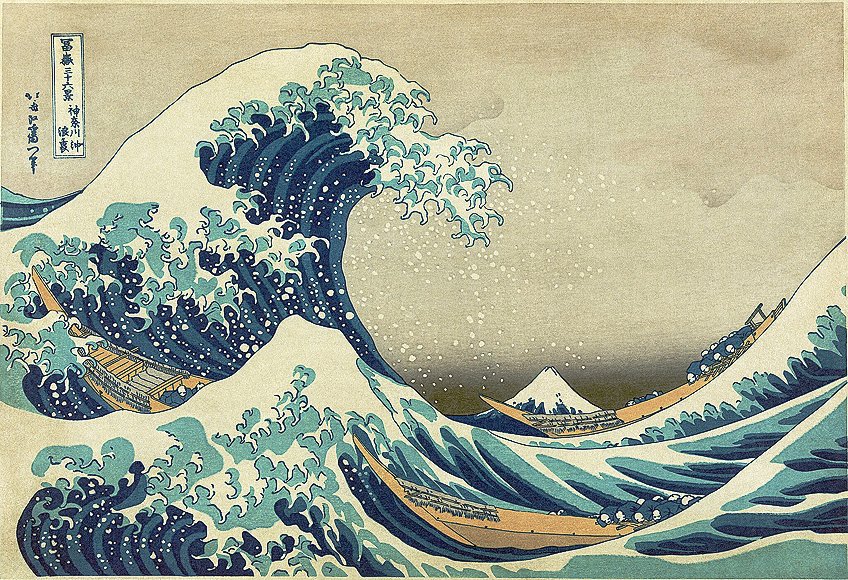
Thunderstorm Beneath the Summit (1831)
| Date | 1831 |
| Medium | Woodblock print |
| Dimensions (cm) | 25.7 × 38 |
| Where Is It Housed? | Various collections |
“Thunderstorm Beneath the Summit” captures a dramatic scene of a thunderstorm near Mount Fuji, emphasizing the contrast between the dark, turbulent sky and the tranquil landscape below. Its importance lies in its ability to convey the intensity and dynamic energy of a storm, showcasing Hokusai’s skill in depicting atmospheric effects and dramatic compositions. The painting’s subject matter evokes a sense of awe and wonder, inviting viewers to contemplate the raw power and majesty of nature.
Its meaning resonates with themes of unpredictability, natural forces, and the sublime beauty found in the midst of chaos, creating a compelling visual narrative that leaves a lasting impression.
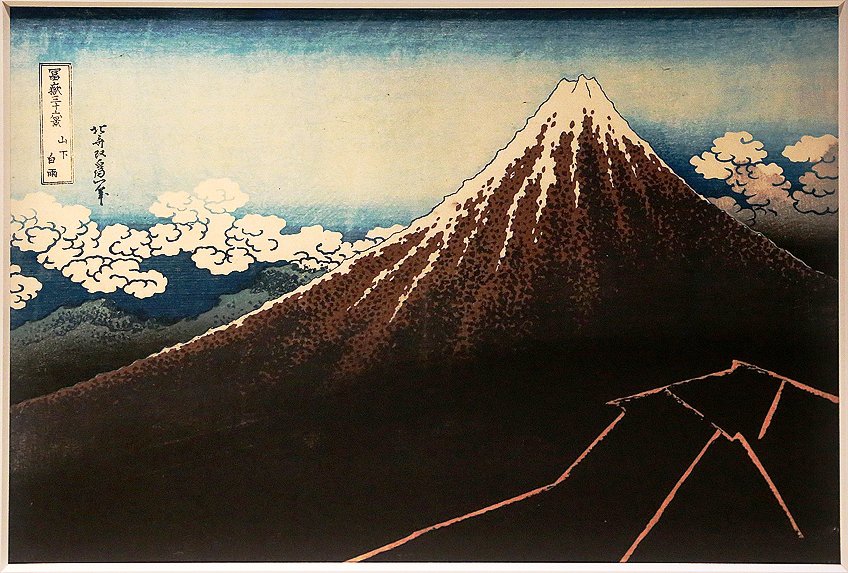
Fine Wind, Clear Morning (Red Fuji) (1831)
| Date | 1831 |
| Medium | Woodblock print |
| Dimensions (cm) | 25.7 × 38 |
| Where Is It Housed? | Metropolitan Museum of Art, New York City, United States |
“Fine Wind, Clear Morning (Red Fuji)” portrays Mount Fuji under a red tint against a clear blue sky, symbolizing a refreshing breeze. Its subject matter celebrates the iconic Japanese landmark, showcasing Hokusai’s fascination with Mount Fuji and its changing appearances. The painting’s importance lies in its vivid depiction of nature’s beauty and the artist’s skill in capturing atmospheric effects. Its meaning reflects a sense of tranquility, optimism, and the eternal cycle of nature, inviting viewers to appreciate the sublime beauty of Mount Fuji in different weather conditions.

Thirty-Six Views of Mount Fuji (1831 – 1833)
| Date | 1831 – 1833 |
| Medium | Woodblock print |
| Dimensions (cm) | Not specified |
| Where Is It Housed? | Metropolitan Museum of Art, New York City, United States |
“Thirty-Six Views of Mount Fuji” is a series of prints depicting Mount Fuji from various perspectives and in different seasons and weather conditions. Its subject matter focuses on the iconic Japanese landmark, showcasing Hokusai’s versatility and creativity in capturing Mount Fuji’s ever-changing appearance. The series’s importance lies in its cultural significance as a comprehensive exploration of Mount Fuji’s symbolic and aesthetic value.
Its meaning resonates with themes of natural beauty, seasonal transitions, and the enduring allure of Japan’s majestic landscapes.

A Tour of the Waterfalls of the Provinces (1833)
| Date | 1833 |
| Medium | Woodblock print |
| Dimensions (cm) | Not specified |
| Where Is It Housed? | Los Angeles County Museum of Art, California, United States |
“A Tour of the Waterfalls of the Provinces” is a series of prints showcasing waterfalls from different provinces of Japan, highlighting Hokusai’s attention to natural landscapes and their dynamic elements. Its subject matter celebrates the majestic beauty of waterfalls, showcasing Hokusai’s mastery of capturing movement and texture. The series’s importance lies in its comprehensive exploration of Japan’s diverse geography and the artist’s ability to convey the power and grandeur of waterfalls. Its meaning resonates with themes of awe, wonder, and the sublime beauty found in nature’s wonders.
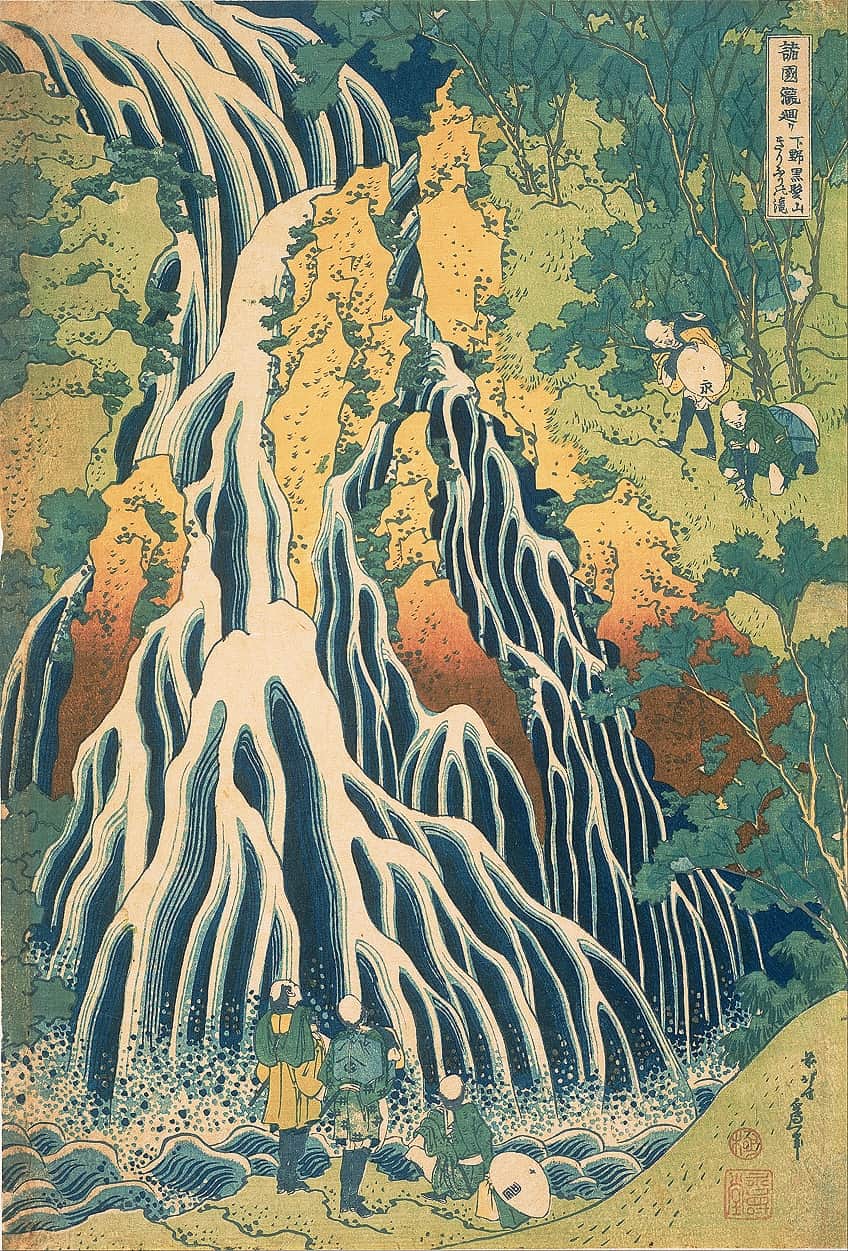
One Hundred Views of Mount Fuji (1834)
| Date | 1834 |
| Medium | Woodblock print |
| Dimensions (cm) | Not specified |
| Where Is It Housed? | Various collections |
“One Hundred Views of Mount Fuji” is another extensive series of prints focusing on Mount Fuji, depicting it from various angles, distances, and perspectives. Its subject matter continues to celebrate the iconic Japanese landmark, showcasing Hokusai’s lifelong fascination with Mount Fuji’s ever-changing appearance. The series’s importance lies in its comprehensive and imaginative portrayal of Mount Fuji’s cultural and aesthetic significance.
Its meaning reflects a deep reverence for nature, Japan’s natural beauty, and the artist’s enduring legacy as a master of landscape art.

Bullfinch and Weeping Cherry Blossoms (1834)
| Date | 1834 |
| Medium | Woodblock print |
| Dimensions (cm) | 25.4 × 19.1 |
| Where Is It Housed? | The Art Institute of Chicago, Illinois, United States |
Bullfinch and Weeping Cherry Blossoms” portrays a delicate and vibrant scene of a bullfinch perched amidst weeping cherry blossoms in full bloom. Its subject matter celebrates the beauty of springtime in Japan, showcasing Hokusai’s skill in depicting flora and fauna with exquisite detail. The painting’s importance lies in its representation of seasonal transitions and the ephemeral beauty of cherry blossoms. Its meaning resonates with themes of renewal, fleeting moments of beauty, and the harmonious coexistence of nature’s elements, creating a visual ode to the wonders of spring.

Katsushika Hokusai’s masterpieces stand as timeless treasures that transcend generations, bridging the past with the present through their profound impact on art and culture. Hokusai’s paintings showcase not only his technical prowess but also his deep connection to nature and Japanese aesthetics. As we reflect on his most famous works, we are reminded of Hokusai’s enduring legacy as a visionary artist whose art continues to inspire and resonate with audiences around the world, cementing his place as an immortal figure in the annals of art history.
Frequently Asked Questions
What Are Some of the Key Characteristics That Make Hokusai’s Paintings Stand Out?
Hokusai’s paintings are characterized by dynamic compositions, vibrant colors, meticulous attention to detail, and a deep appreciation for nature and Japanese culture. These elements contribute to the enduring appeal and significance of his artworks.
How Did Hokusai’s Artworks Influence the Development of Japanese Art?
Hokusai’s artworks played a pivotal role in shaping Japanese art, particularly in the ukiyo-e genre. His innovative techniques, such as the use of perspective and dynamic brushwork, inspired generations of artists and contributed to the evolution of artistic styles in Japan.
What Is the Enduring Legacy of Hokusai’s Paintings in the Art World?
Hokusai’s paintings have left an enduring legacy in the art world, influencing artists across cultures and generations. His mastery of technique, innovation in artistic expression, and timeless themes continue to inspire and captivate art enthusiasts around the globe.
Isabella studied at the University of Cape Town in South Africa and graduated with a Bachelor of Arts majoring in English Literature & Language and Psychology. Throughout her undergraduate years, she took Art History as an additional subject and absolutely loved it. Building on from her art history knowledge that began in high school, art has always been a particular area of fascination for her. From learning about artworks previously unknown to her, or sharpening her existing understanding of specific works, the ability to continue learning within this interesting sphere excites her greatly.
Her focal points of interest in art history encompass profiling specific artists and art movements, as it is these areas where she is able to really dig deep into the rich narrative of the art world. Additionally, she particularly enjoys exploring the different artistic styles of the 20th century, as well as the important impact that female artists have had on the development of art history.
Learn more about Isabella Meyer and the Art in Context Team.
Cite this Article
Isabella, Meyer, “Katsushika Hokusai Paintings – A Journey Through Time.” Art in Context. March 26, 2024. URL: https://artincontext.org/katsushika-hokusai-paintings/
Meyer, I. (2024, 26 March). Katsushika Hokusai Paintings – A Journey Through Time. Art in Context. https://artincontext.org/katsushika-hokusai-paintings/
Meyer, Isabella. “Katsushika Hokusai Paintings – A Journey Through Time.” Art in Context, March 26, 2024. https://artincontext.org/katsushika-hokusai-paintings/.


